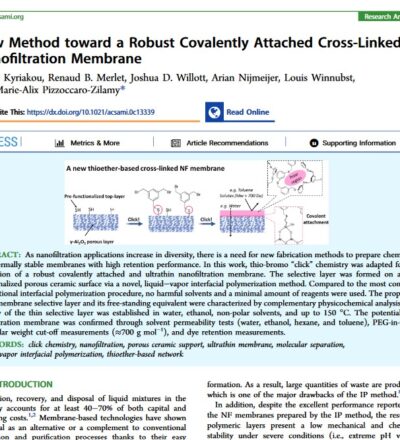As nanofiltration applications increase in diversity, there is a need for new fabrication methods to prepare chemically and thermally stable membranes with high retention performance. In this work, thio-bromo “click” chemistry was adapted for the fabrication of a robust covalently attached and ultrathin nanofiltration membrane. The selective layer was formed on a pre-functionalized porous ceramic surface via a novel, liquid−vapor interfacial polymerization method.
Compared to the most common conventional interfacial polymerization procedure, no harmful solvents and a minimal amount of reagents were used.
The properties of the membrane selective layer and its free-standing equivalent were characterized by complementary physicochemical analysis. The stability of the thin selective layer was established in water, ethanol, non-polar solvents, and up to 150 °C. The potential as a nanofiltration membrane was confirmed through solvent permeability tests (water, ethanol, hexane, and toluene), PEG-in-water molecular weight cut-off measurements (≈700 g mol−1 ), and dye retention measurements.
KEYWORDS: click chemistry, nanofiltration, porous ceramic support, ultrathin membrane, molecular separation,
liquid−vapor interfacial polymerization, thioether-based network
Download your free copy
Our publications are free to access. Simply provide your first name and email address to download.
